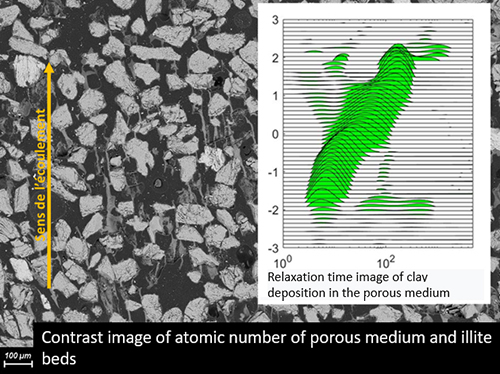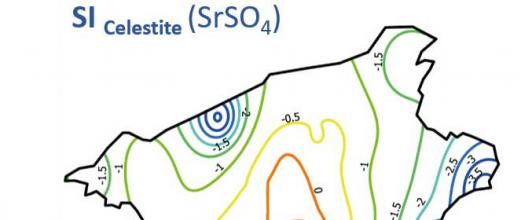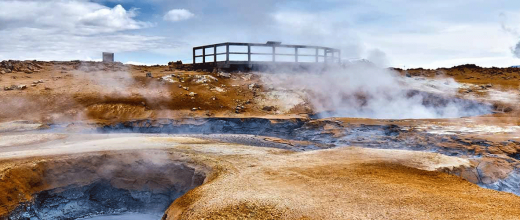14.09.2023
3 minutes of reading
Over time, high-temperature geothermal sites can experience plugging problems. The cause: extremely fine clays in the reinjection water, which progressively reduce the permeability of the underground environment, despite the treatments applied to the surface water. Thesis work has shed light on the mechanisms involved, and provided a glimpse of the means of action that will enable injectivity to be maintained.
The problem of declining injectivity
Geothermal energy production harnesses the heat of a fluid present in the deep subsurface, and to activate it, a key stage in the operating cycle is the reinjection of water into the subsurface. In a porous geological structure, the flow of geothermal fluid carries with it solid particles for which the rocks act as a filter. The capture of these particles causes the permeability of the porous medium to gradually decrease, which can lead to a drastic reduction in injectivity and eventual failure of the industrial operation.
This problem of declining injectivity was encountered in the 1980s in the Triassic sandstone reservoirs of the Paris Basin, due to the deposition of nanoparticles of clay in the natural porous media, leading to plugging problems. These difficulties are still encountered today, despite massive surface filtration of particles larger than 1µm upstream of reinjection, which is supposed to guarantee fluid with a low concentration and transported particle sizes well below (two orders of magnitude) the pore thresholds of the rocks. To gain a more detailed understanding of the damage mechanisms in this type of geological formation, research has been carried out as part of a doctoral project [1-3] to: (1) identify the clays responsible for plugging, (2) study the stability of clays under geothermal conditions, and finally (3) assess the drop in injectivity caused by the deposition of clay particles in porous media.
Identifying the clays that cause plugging
A characterization of natural samples from a geothermal well was carried out. X-ray diffraction (XRD), followed by chemical and morphological analysis using a scanning electron microscope (SEM) coupled with energy dispersive spectroscopy (EDS), were used to identify the illites responsible, which are predominant and can be displaced by the flow of fluid in the targeted sedimentary environments.
1 FEX-1 well in the Feigneux series (national index: 129-1-140) located 60km northeast of Paris in the Chaunoy sandstone formation
2 Non-expansive clay minerals of the mica group common to many soils and substrates and mainly formed from smectites (swelling clay minerals) by the incorporation of potassium between layers during sediment diagenesis
.
Study of clay stability under geothermal conditions
The stability of clay suspensions under geothermal conditions, upstream of their injection into porous media, controls aggregate formation during transport and fluid flow in the geological formation despite the fluid being filtered at the surface. The aggregation kinetics of the clays identified above were studied by dynamic light scattering (DLS) under different physico-chemical conditions (temperature, particle concentration, salinity, etc.).
Study of the drop in injectivity caused by the deposition of clay particles in porous media.
Experiments involving the injection of clay suspensions similar to those in the FEX-1 well were carried out under different hydrodynamic and physicochemical conditions. In particular, the impact of injection flow rate, fluid salinity, temperature and particle concentration was studied. Interpretations based on the head loss generated by the deposition of particles in the porosity, supplemented by 2D nuclear magnetic resonance (NMR) and EDS-SEM imaging, have shed light on the behavior of clays during reinjection, and have led to the development of possible solutions to overcome this problem.
Moving towards predictive digital modeling
One of the most striking results of this study is summarized in the figure below, which illustrates the micrometric-scale alteration of the pore network observed using both SEM and NMR. By combining these techniques, we now have a better understanding of how to interpret head loss measurements in flow, and thereby improve the accuracy of predictive numerical modelling.
References :
[1] Thesis by I. Raies : Identification et compréhension des mécanismes de déstabilisation colloïdale dans les procédés géothermiques, soutenue le 20-12-2022 (Identification and understanding of colloidal destabilization mechanisms in geothermal processes, defended on 20-12-2022) (CY Cergy Paris Université), as part of the Doctoral School of Sciences and Engineering, in partnership with GEC - Geosciences and Environment Cergy Laboratory and IFPEN, jury: Beatrice Ledesert, Benjamin Brigaud, Henri Bertin, Eva Schill, Pierre Ungemach, Jean Schmittbuhl, Eric Kohler, Marc Fleury.
[2] Formation damage induced by clay colloids deposition in Triassic clastic geothermal fields: Insights from an experimental approach, 2023, Raies Ines, Kohler Eric, Fleury Marc, Pédel Nicolas, Ledésert Béatrice, Applied Clay Science 234, 106868 DOI: https://doi.org/10.1016/j.clay.2023.106868
[3] Clay-induced permeability decline in sandstone reservoirs: Insights from a coupled NMR-SEM experimental approach (2023) Raies Ines, Fleury Marc, Kohler Eric, Pédel Nicolas, Ledésert Béatrice, Geothermics 114, 102784 DOI: https://doi.org/10.1016/j.geothermics.2023.102784
Scientific contact : Eric KOHLER








